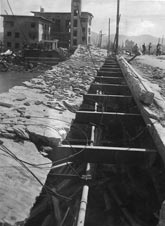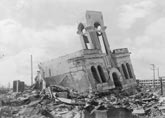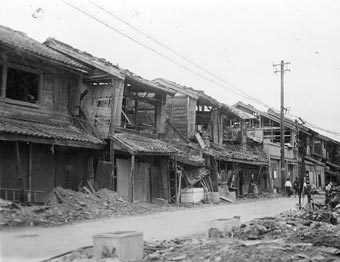Entering a City in Ruins
Filming by the Civil Engineering and Architectural Team
The civil engineering and architectural team mainly filmed blast damage to buildings, trees and shrubs. The film started with a general description of the damage, then presented damage to buildings at certain distances moving out from the hypocenter. Shigeru Miki, cameraman for the civil engineering and architectural team, took over 200 still photographs during the filming.

[34]
View toward southeast from Chugoku Shimbun Company
October 1945 Kami-nagarekawa-cho
870m from the hypocenter Photo by Shigeru Miki
Since many of the houses and buildings in this area were made of wood, almost none of the structures remained. The entire area was burned to the ground. The roadways, however, were pooled with water from a rainstorm.
|

[35] |
[35]
Aioi Bridge, with sidewalk thrust upward
October 1945 Aioi Bridge
300m from the hypocenter Photo by Shigeru Miki
This photograph was taken from the west toward the east. The blast caused the parapet to tumble over and the sidewalk on the north side to shift to the upstream side. Also, when the blast bounced off the water surface, it caused the sidewalk portion to thrust upward about 1.5 meters. |

[36]
Hiroshima Prefectural Industrial Promotion Hall (now, A-bomb Dome)
October 1945 Sarugaku-cho (now, Ote-machi 1-chome)
160m from the hypocenter Photo by Shigeru Miki
This photograph was taken from the southeast side of A-bomb Dome. Since the building was hit by the blast from nearly directly above, portions of the walls escaped collapse. |

[37]
Clock shop tilting from blast
October 1945 Harimaya-cho (now, Hondori) Shimomura Jewelers
620m from the hypocenter Photo by Shigeru Miki
Some reinforced-concrete buildings collapsed as a result of their structural features. The upper part of this clock shop was supported mainly by the walls on both sides. The first floor of the shop crumbled, while the second floor and clock tower tilted in the direction opposite of the hypocenter. |

[38] |
[38]
Row of damaged residential buildings
October 7, 1945 Near Minami-kaniya-cho
Approx. 2,800m from the hypocenter Photo by Shigeru Miki
In areas further away from the hypocenter, there was less damage to houses and buildings. Depending on their construction, however, some structures collapsed as far as about four kilometers away. The images filmed by the civil engineering and architectural team can be used to confirm the extent of damage in relation to the distance from the hypocenter. |





